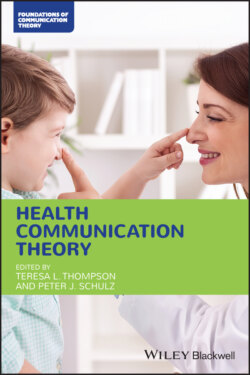Читать книгу Health Communication Theory - Группа авторов - Страница 45
Rhetoric of Health and Medicine
ОглавлениеWithin a university communication department, shared theoretical constructs (e.g. narrative, metaphor, ideology, hegemony) can unite methodological differences – namely, the critical‐interpretive health communication and the rhetoric of health and medicine – as scholars investigate meaning‐making in a variety of health‐related contexts (see Keranën 2015; Lynch and Zoller 2015). Rhetoric can be defined in various ways, but it generally refers to the study of persuasive discourses in any number of forms, including spoken, written, mediated, or face‐to‐face. In health communication, rhetorical criticism has been “invaluable in answering important questions about how best to communicate health information, the consequences of those messages, and how cultures come to understand and address particular health concerns” (Stokes 2014, p. 279).
Beyond and within health communication (see Lynch and Zoller 2015), rhetoric of health and medicine is a burgeoning, robust area of scholarship, spanning rhetorical studies and the medical humanities, as well as multiple communicative contexts and a wide swath of discourse domains. Indeed, “health and medical rhetoric infuses every aspect of healthcare” (Keranën 2014, p. 1173) from insurance forms, patient intake histories, and clinical notes through online support groups, digital health information, pharmaceutical advertisements, email exchanges between patients and providers, and mass‐mediated representations of illness. Scholarship in the rhetoric of health and medicine offers a humanistic perspective on the exigencies, functions, and impacts of health‐related discourse.
Stokes (2014) outlined four theoretical assumptions that – echoing the other frameworks in this chapter – demonstrate the commitment of rhetoricians as critics to keep close relationship with the discourses they critique. First, rhetoricians assume reality is constructed through language and culture is perpetuated through discourse. To that end, they are interested in both the measurable outcomes of a campaign and in the ways that campaign could shift cultural views, as demonstrated, for example, in campaign analyses of the use of humor in combating stigma about mental health in men (Mocarski and Butler 2016) and in the endorsement of personal responsibility for managing risks of infection (Brown 2019). Second, rhetoricians acknowledge that a neutral stance is both impossible and unethical, given that they bring their own ideologies and biases to bear when studying a particular phenomenon. Third, rhetoricians recognize that their perspective is selective. As such, any rhetorical act can be read in numerous ways, and audiences may take away different meanings from a particular health message. Finally, rhetoricians debate what constitutes an object of critique, noting that it could be one particular persuasive discourse or an assembly of texts and artifacts. As Lisa Keranën, an influential rhetorician of health and medicine, noted:
Rhetorical studies of health and medicine have increasingly embraced theoretical frameworks and methods that can account for the complexities of language as social action, shifting our focus from texts to the networks, ecologies, and activity systems that shape health‐related discourse and its effects. Many rhetoricians of health and medicine are looking beyond traditional rhetorical theory and methods – with their emphases on the persuasive moves of authors in texts – to explore other means of rhetorical inquiry… that foreground interconnectedness, materiality, and movement in health and medicine.
(Scott, Segal, and Keranën 2013, p. 3)
Indeed, Jensen (2015) positioned the articulation and tracing of health‐related arguments in and through time as a major objective of scholarship in rhetoric of health and medicine, and she offered two different but related orientations for engaging this approach. In the first, research focuses on the interaction of different kinds of rhetoric across a largely chronological timeline to constitute broader health landscapes. As an example, Jensen (2016) drew from doctor–patient correspondence, oral histories, and contemporary popular and scientific news coverage to trace the transformation of language surrounding infertility and the implications of those rhetorical constructions on individuals and the societies in which they live.
In the second approach, research demonstrates how historical arguments about health percolate up at distinct, chronologically disjointed moments: “The exploration of health as it was conceptualized in even the distant past can be understood… as a valuable contribution to delineating conceptualizations of health today that may not follow a linear or rational logic” (Jensen 2015, p. 524). To illustrate, consider the notable study on mothering, media, and medical expertise conducted by historian Bethany Johnson and health communication scholar Maggie Quinlan (2019). They engaged historical texts (e.g. doctors’ notes and family papers) and present‐day social media texts (e.g. comments and hashtags) to discover how such discourses have challenged and continue to challenge and create expertise and power relations in defining the good mother. Other studies have examined the rhetorical work of genres, such as Cole and Carmon’s (2019) analysis of addiction‐related obituaries, and the rhetoric of a particular area or topic, like Miller’s (2019) analysis of fat stigma as rhetorical disability or Alderton’s (2018) analysis of the aesthetics of self‐harm (i.e. visual rhetoric) in online communities.
